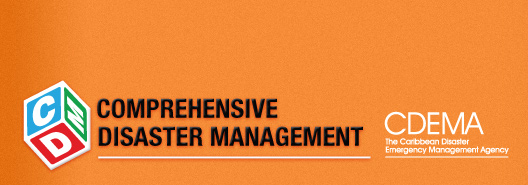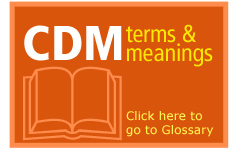
CDM Glossary
There are 29 entries in this glossary.| Term | Definition |
|---|---|
| Anthropogenic hazards |
Hazards created through the action of human activity. (Baastel-ESL and Stakeholders) |
| Capacity |
Physical social, economic and institutional means as well as skilled personal or collective attributes such as leadership and management. (ISDR) |
| Capacity building |
Efforts aimed to develop human skills or societal infrastructures within a community or organization needed to reduce the level of risk. Capacity building also includes development of institutional, financial, political and other resources, such as technology at different levels and sectors of the society. (ISDR) |
| CARICOM Framework |
Ten year (2005-2015) Framework for disaster management in the Caribbean presented through CDERA at the World Conference on Disaster Reduction (WCDR), Kobe, Japan, 2005 as input to the Hyogo Framework for Action 2005-2015. (Baastel-ESL) |
| Community Resilience |
The ability of a community to cope with the effects of a hazardous event through appropriate prevention, mitigation, preparedness, response and recovery mechanisms (adapted from WCDR). |
| Comprehensive Disaster Management (CDM) |
Comprehensive Disaster Management which includes attention to all phases of the Disaster Management Cycle – prevention, mitigation, preparedness and response, recovery and rehabilitation (CDERA). It includes emphasis on reducing risk. This nomenclature is the term that reflects the global trend in the discipline for increased focus on risk management and the intense desire among disaster management Stakeholders in the Caribbean to accelerate initiatives in promoting disaster loss reduction. DRM as defined by ISDR is presented below. |
| Coping Capacity |
The means by which people or organizations use available resources and abilities to face adverse consequences that could lead to a disaster. In general, this involves managing resources, both in normal times as well as during crises or adverse conditions. The strengthening of coping capacities usually builds resilience to withstand the effects of natural and human-induced hazards. (ISDR) |
| Disaster Risk Management (DRM) |
The systematic process of using administrative decisions, organization, operational skills and capacities to implement policies, strategies and coping capacities of the society and communities to lessen the impacts of natural hazards and related environmental and technological disasters. This comprises all forms of activities, including structural and nonstructural measures to avoid (prevention) or to limit (mitigation and preparedness) adverse effects of hazards. (ISDR) |
| Disaster Risk Reduction (DRR) |
The conceptual framework of elements considered with the possibilities to minimize vulnerabilities and disaster risks throughout a society, to avoid (prevention) or to limit (mitigation and preparedness) the adverse impacts of hazards, within the broad context of sustainable development. DRR involves:
|
| Donor Harmonization |
Collaboration among donors or development partners on programme initiatives so as to avoid duplication and to optimise resource allocation (Eastern Caribbean Donor Group /Development Partners) |
| Early Warning |
The provision of the means by which people or organizations, use available resources and abilities to face adverse consequences that could lead to a disaster. In general, this involves managing resources, both in normal times as well as during crises or adverse conditions. The strengthening of coping capacities usually builds resilience to withstand the effects of natural and human-induced hazards. (ISDR) |
| Intermediate Results (IRs) |
Interim Targets set to measure progress toward achievement of Strategic Objective. (CDERA CDM Strategy) |
| ISDR |
ISDR International Strategy for Disaster Reduction |
| Mainstreaming |
Making Comprehensive Disaster management an integral dimension of the policies and programmes in all political, economic and societal spheres. (BCPR) |
| Mitigation |
Structural and non-structural measures undertaken to limit the adverse impact of natural hazards, environmental degradation and technological hazards. (ISDR) |
|
Looking for:
|











